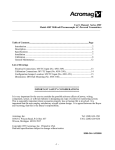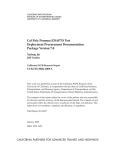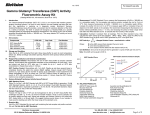Download Product Description Rhodamine Secondary Standards
Transcript
Product Description Rhodamine Secondary Standards The Purpose of Secondary Standards The purpose of using a secondary standard is to have a quick and easy way to check the calibration of your fluorometer. This saves the user time and money, since one will not need to purchase or prepare primary calibrators (chlorophyll or phycocyanin) each time the instrument is used. Note that the secondary standards are not designed to be used for primary calibration; their purpose is for gauging calibration prior to instrument use. Sometimes this is referred to as detecting the “drift” of the instrument. Product Description and Handling Rhodamine B is a stable red fluorescent molecule that absorbs at 555 nm and emits at 580 nm. While this combination of excitation/emission maxima does not correspond exactly to those of chlorophyll or phycocyanin, rhodamine’s fluorescence spectrum is broad enough that it is still capable of being measured on both channels. Therefore, when treated like a sample to be measured, rhodamine fluorescence will be detected and can be used to check the calibration of a fluorometer. Rhodamine B has the same fluorescent properties as the common water dye Rhodamine WT (Smart and Laidlaw, 1977)1. Rhodamine B was dissolved in ethanol, and serial dilutions were used to arrive at the approximate concentrations shown in the table below under Product Analysis. These are the final concentrations that were prepared in a proprietary solid phase formulation, in a 0.2 mL tube specifically for use with the Amiscience FluoroQuik fluorometers. Once received, the rhodamine standards should be stored in the dark at room temperature. Directions for Use After primary calibration of a channel, the secondary standards should be measured and recorded in a secondary standard log. Each time the rhodamine standards are used, they (and the fluorometer) should be at the same temperature that the primary calibration and the original secondary standard readings were performed. Each time the instrument is used, the exact same set of secondary standards can be measured again (as if they were samples), and the values recorded in the same log. By comparison to the original values, the user will be able to observe “drift,” meaning that the values of the secondary standards will change. The amount of drift that is acceptable is determined by the user, and when unacceptable, the instrument should be recalibrated with primary standards. Two standards of a high and a low rhodamine concentration and one blank with no rhodamine have been provided as a “set.” They should be used as follows: 1. If not already done, perform primary calibration of the desired channel, as described in the user’s manual or in product literature that accompanies Beagle’s phycocyanin or chlorophyll primary calibrators. 2. Measure the rhodamine standards and record their reading in the log. 3. Repeat measuring the rhodamine standards before each sample is measured. 4. If the change in the rhodamine measurements is too large, recalibrate the fluorometer with primary calibrators. These steps should be performed before every sample measurement, and as stated above, comparison with the original values will help one to detect drift of the fluorometer’s primary calibration. Beagle’s secondary standard set is designed to give the user maximum flexibility: both standards can be used in both channels. In our experience though, the higher-concentration standard is best for the chlorophyll channel, and the lower-concentration standard works best with the phycocyanin channel. The user can choose which secondary standard 1 Smart, PL and Laidlaw, IMS. An Evaluation of Some Fluorescent Dyes for Water Tracing. Water Resources Research: 13 (1). 1997. Beagle Bioproducts, 959 Schrock Road, Columbus, OH 43229, [email protected] 1 of 2 that appears to encompass the range of measurements that are most relevant for their current experiment or measurements, however, and it is just fine to measure both standards under each channel. Note that standard 0 has no rhodamine; it is provided simply for the user to understand background fluorescence that occurs due to the solid state material. It also can be used to measure drift. The standards have a fluorescent signal that is presumed stable for 2 years (currently being verified by ongoing studies). Though the fluorescent signal is stable, rhodamine is very sensitive to changes in temperature, where warmer temperatures result in a decreased fluorescence compared to cooler temperatures. In fact, fluorescence in general is sensitive to temperature, and so depending upon the user’s tolerance for these fluctuations it is advisable to do secondary standard measurements at the same temperature when recording measurements in a log. It may likewise be useful to record temperature measurements in the secondary standard log, so that with time trends relative to this effect will be better understood for your instrument. Product Analysis Performed By: Date: Production Lot #: Set#: Expiration Date: Ryan Farmer July 28, 2014 RHOD-1002 A 2 years (presumed as of July 2014, study ongoing) Each standard was measured on both the phycocyanin and chlorophyll channels of an Amiscience FluoroQuik dual channel fluorometer. The relative fluorescent units (RFUs) from each channel are listed in the table below for each standard. Due to variations in fluorometers, these RFUs are specific to this individual fluorometer only, and these numbers are provided as an example of what the user might expect from their own fluorometer. When measured on a calibrated channel, the output may change considerably, but the relative change among values should be similar. Standard 0 (white label) is a blank. Channel RFU1 Standard Label color Concentration Blank3 white Low High 2 Phycocyanin Chlorophyll 0 mg/L 127 1730 blue 0.03 mg/L 194 1943 green 1.5 mg/L 6738 11671 1 The Relative Fluorescent Units (RFUs) were measured on a FluoroQuik portable fluorometer. The approximate concentration of rhodamine that is contained in this standard. This is provided for understanding of the general range of concentrations, and should not be considered as a number for primary calibration or direct linear correlation with RFUs or sample measurements. 3 This standard contains no rhodamine. RFUs from this sample merely demonstrate that there is some background from the solid resin that contains the rhodamine in the other samples. Use of this standard for measuring drift is optional. 2 Beagle Bioproducts, 959 Schrock Road, Columbus, OH 43229, [email protected] 2 of 2









